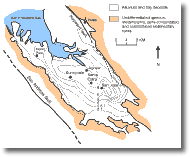
Exercises for Land Stability, Including Subsidence
If you cannot find three or four articles or brief news items over about a month’s time span then make similar observations about historical events over the last 12 months.
2. Using the method of moments, calculate the safety factor of an embankment with the following characteristics:
3. A large mass of rock and soil lies on the side of a steep mountain front, 1 km above the valley floor, and is gradually moving downslope. A town of 15,000 residents is located 2 km downslope from the mountain front and 200 m above the valley in line with the unstable mass. Using the information provided below, if the rock mass and soil fail suddenly, how far might the landslide material travel? The estimated volume of unstable material is 10 million m3. What should the town do? Analysis of large landslides involves establishing parameters such as total vertical fall height (H), slide mass (m), its velocity of movement (V), its maximum runup (r), net vertical fall (h = H – r) and the angle of slope (α) over which the landslide moves. The velocity for landslides can be estimated from the height the runup on obstacles or valley sides:
Where g = acceleration due to gravity, 9.8 ms-1. This method does not take into account frictional losses as the mass flows uphill against gravity so is only a minimum value. The average coefficient of friction (µ) can be estimated from Figure 5 (Large Landslides) following these questions. This is derived from a plot of landslide volume and calculated coefficients of friction for a large number of landslides. Substituting µ and h into the following equation allows us to calculate the horizontal distance the landslide might have travelled.
|
||||||||||
|
||||||||||
|
||||||||||
